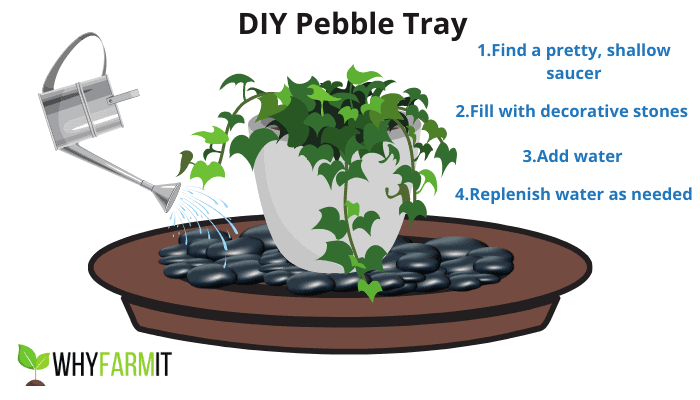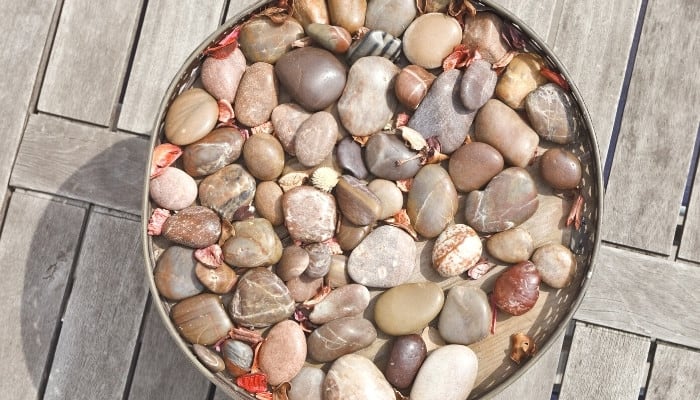A shallow tray containing pebbles and a layer of water is commonly referred to as a pebble tray. This method, also known as a pebble tray, is a simple do-it-yourself approach for safeguarding plant roots and adjusting humidity levels.
Do pebble trays increase humidity? Pebble trays increase humidity levels directly above the water level. Water evaporation occurs in the pebble tray, causing increased humidity. If you don’t want your plant’s roots sitting in water or need to raise the humidity around the plant, a pebble tray will do the trick.
Read on below and find out more about pebble trays and exactly how it is that they work!
Pebble Trays: What They Are & How They Work
Pebble trays are exactly as they sound; trays filled with pebbles. They are just deep enough to hold a bit of water for evaporation, and they provide a nice aesthetic as well.
The purpose of a pebble tray is multi-faceted; they help raise humidity levels around plants as well as protect said plants’ roots from water damage and root rot.
Pebble Trays Explained
As mentioned above, pebble trays are simple shallow trays or dishes that hold both pebbles (or small rocks) and a small volume of water.
The pebbles held in the tray are a physical barrier that protects the plant sitting on top of it from being exposed to too much water at the root level.
Furthermore, the bit of water that’s present in the tray slowly evaporates and causes the humidity directly surrounding the plant to increase slightly.
Why Pebble Trays Work
Pebbles trays work because of their simple design (and basic science).
The pebbles or rocks keep the plant on top from being wet constantly, and the water in the tray evaporates, rises, and increases the moisture level around the plant.
Why Do Humidity Trays Need Pebbles?
Humidity trays need pebbles to hold the plant(s) above the water level. The pebble’s physical presence helps prevent root rot and other water-based issues.
How Much Do Pebble Trays Increase Humidity?
When water held in pebble trays evaporates, it rises up into the air.
If a potted plant with drainage holes is properly situated on top of the tray, the evaporating water enters the bottom of the plant, increasing the moisture of the contents of the pot (soil and roots).
Some of the evaporation may also rise up around the sides of the pot and travel up through the branches and leaves of the plant, again raising humidity and moisture levels directly surrounding the plant.
The exact amount of increase in humidity levels is unknown and varies from tray to tray as well as plant species.
However, one interesting experiment indicated that in the warm months, at 1 1/2 inches above the tray, the humidity rose to 7%, but in colder months, the humidity level dropped to only 3% when measured at the same height.
Size Matters
As within many aspects of life, size matters. In regards to pebble trays, the more plants you’re growing, the bigger the tray that’s needed.
Likewise, larger pebble trays are suggested for larger plants as they require more water, space, and possibly humidity levels.
Even more, you’ll need a larger tray if you’re relying on your pebble tray to raise the humidity level of plants in a large room with lots of air space.
The water in the tray is more likely to evaporate quickly in a bigger room, hence a large tray is recommended.
What Size Pebbles Are Best for Humidity Trays
The type and size of pebbles best for humidity trays vary depending on the size of the tray and the type of plants it supports.
That said, river rocks, gravel, glass, and other types of small (pea size) pebbles that don’t absorb water themselves are preferred.
In certain cases, when larger trays and plants are concerned, small rocks (bigger than pebbles, but small enough to close your fist around) may be more efficient.
Which Plants Benefit From a Pebble Tray
Plants that benefit the most from pebble trays are typically indoor plants, even more specifically, indoor houseplants that increase the humidity in your home (if even just by a little bit).
A few of these plants include:
- Bamboo
- English ivy
- Ferns
- Ficus
- Jade
- Peace lily
- Spider plant
- Schefflera
Pebble Tray Ideas
Pebble trays can be store bought, but they are also super-easy to create from old stuff you already have around the house.
A few great DIY pebble tray ideas to get your creative juices flowing:
- Pie dish
- Cake pan
- Cookie sheet
- Pretty saucer
- Dish
- Shallow tote
- Birdbath basin
- Any other container with a height of approximately 1 inch.
How To Make a Pebble Tray
Making a DIY pebble tray is simple:
1. Select a Tray and Clean it
Pick a tray (see the ideas listed above), and clean it with water and a bit of bleach.
2. Choose Pebbles and Clean Them
Select some small pebbles that’ll fit your tray and gather them up to be cleaned. Run hot water over them, and wash them with a bit of dish soap.
3. Fill Tray with Pebbles and Water
Take your clean and ready-to-use tray, fill it with pebbles, and then add enough water that the pebbles are almost fully submerged.
That’s it! You’re done.
Now you may set your plants on it and follow up by keeping it topped off with water. You’ll also need to clean it from time to time.

Best Pebble Tray for Humidity
Below, we provide a mini-review of three of the best pebble trays for humidity:
9GreenBox Humidity Tray With Pebbles
The 9GreenBox Humidity Tray With Pebbles is a rectangular pebble tray made of wood and plastic that measures around an inch tall.
The tray is 7-inches wide on the bottom, and 9-inches wide on the top.
This tray holds two plants such as miniature potted trees or several smaller plants in pots. It is perfect for bonsai and comes with decorative pebbles that look great indoors.
Pros:
- Great for bonsai trees
- Includes decorative pebbles
- Affordable
- Holds more plants than some
Cons:
- Rectangular shape isn’t everyone’s cup of tea
Tite Heavy-Duty 3 Pack
This 3-pack of TITE pebble trays is 100% eco-friendly and comes in green, yellow, gray, brown, or black.
Each tray is in the shape of a saucer and measures 6, 8, 10, or 12-inches wide on top.
These trays are break proof and leak proof and are the best shape available for potted plants to drain into. They work well indoors and outdoors.
Pros:
- Available in several sizes and colors
- Works well inside and outside
- Perfect shape for catching draining water
- No-break and no-leak design
- Made with eco-friendly material
Cons:
- All colors may not be available
Sarasota 6 Pack
The Sarasota pebble trays come in a 6-pack, are lightweight, and have a heavy-duty design.
Two trays measure 9.4 inches in diameter, two trays are 10.4 inches, and two are 12 inches across. All of the trays are 1.4 inches tall.
The trays are made of heavy-duty PP material and come in dark gray, red, or white. They are an ideal shape for holding a single large plant or a few smaller ones.
Pros:
- Available in a wide variety of sizes
- Lightweight and heavy duty
- High-quality craftsmanship
- Excellent for gardening or DIY projects
- Works well with most potted plants
Cons:
- 6 trays may be more than you need or want
Related Questions:
Do Pebble Trays Attract Pests?
Pebble trays themselves rarely attract pests. However, the pebbles, if not clean, may draw pests inside.
In reality, pebble trays actually do more to reduce a pest-friendly environment than to create one.
How Do You Keep Pebble Trays Clean?
After being in use for a while, the pebbles and tray may begin building up gunk and/or algae.
To clean your pebble tray, simply remove the pebbles, wash them under running water, and scrub the tray with water and a tiny bit of bleach.
A Final Word About Pebble Trays
Pebble trays are a great way to keep your plant’s moisture and humidity levels managed well.
They are also good for protecting the roots and soil of your plants from needless exposure to excess water.
Depending on your choice of materials, they can lend a calm, serene atmosphere wherever you use them.

